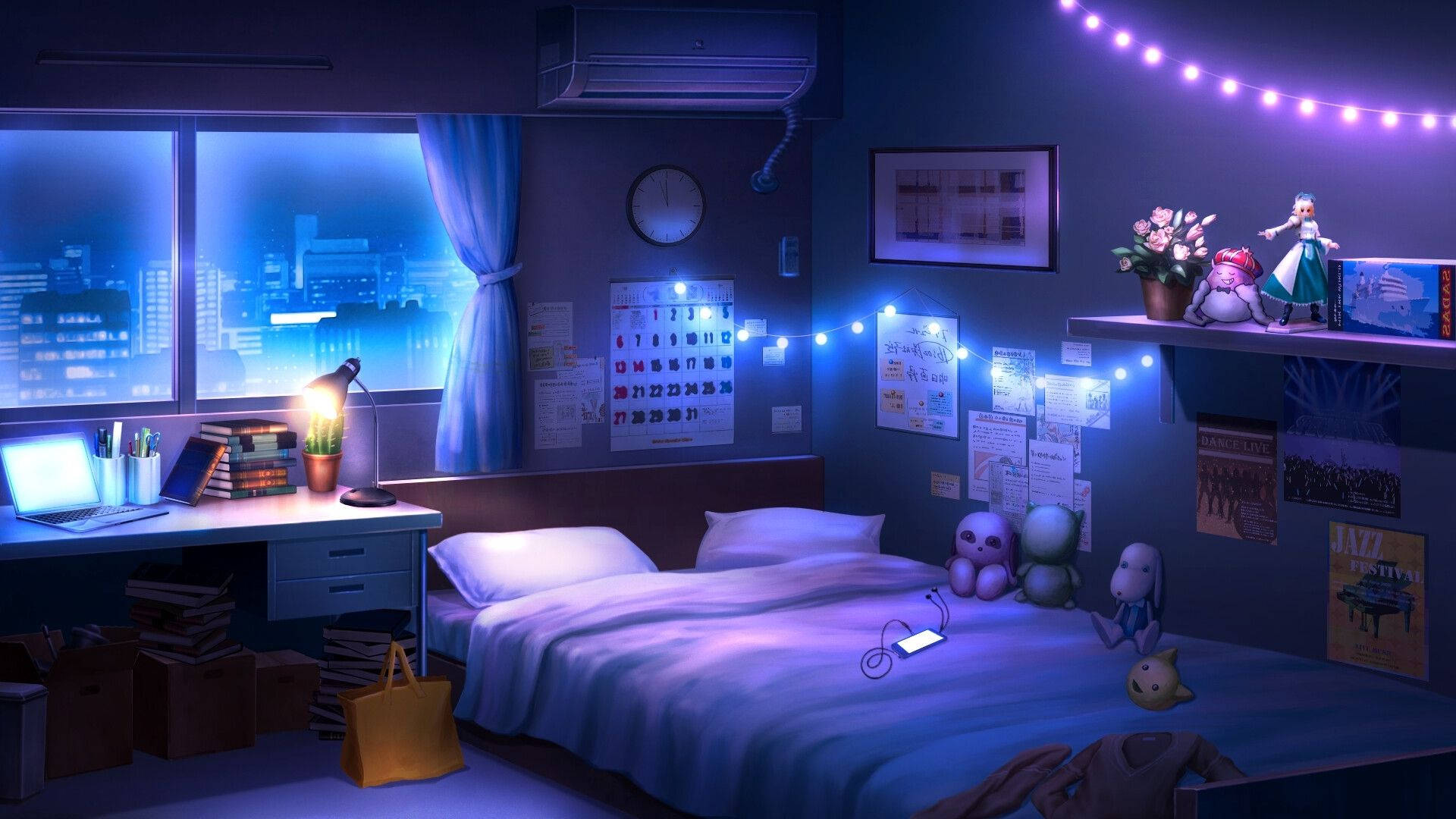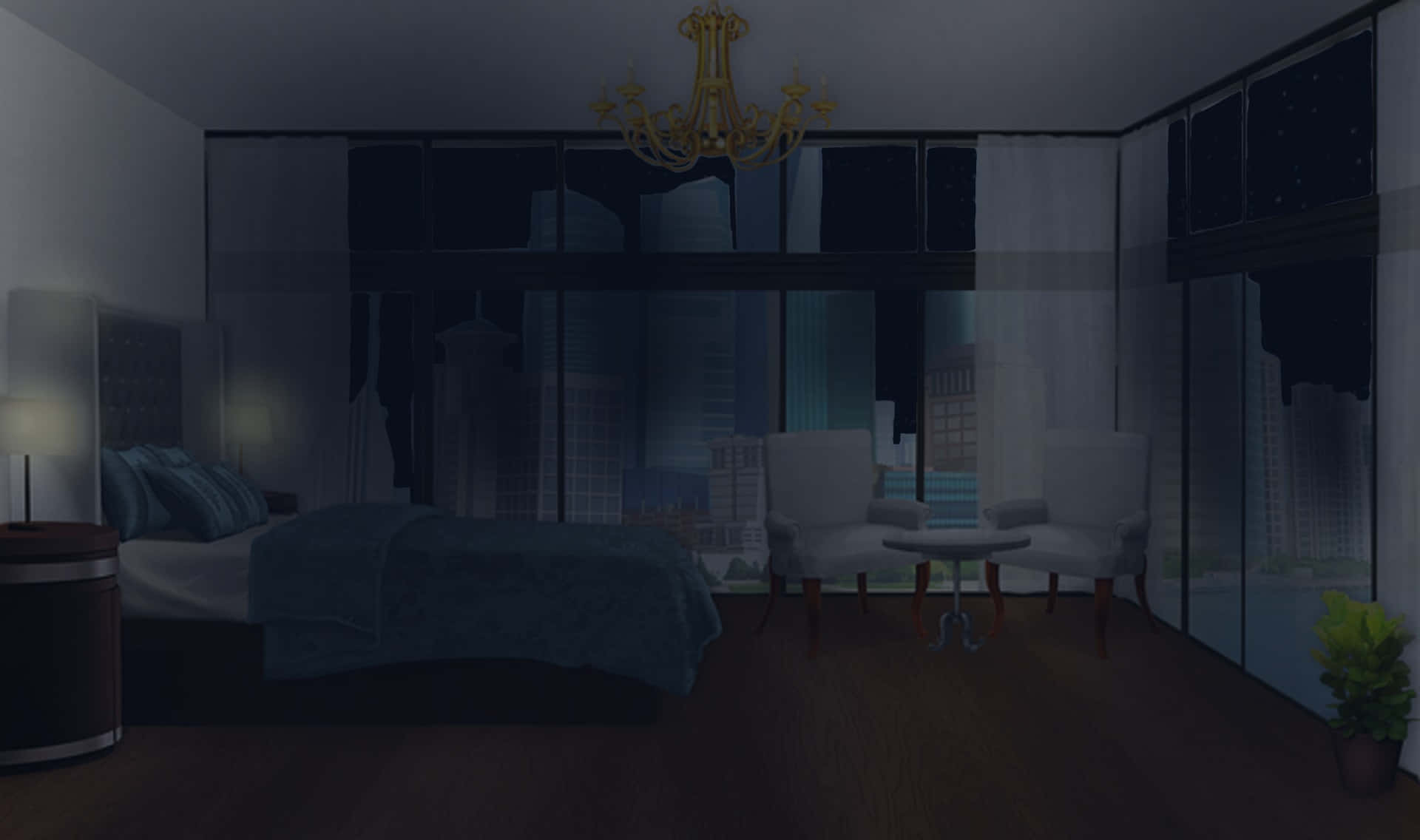The Aesthetics of Darkness in Anime Bedroom Backgrounds: Dark Bedroom Background Anime

The darkness of an anime bedroom background serves as more than just a visual element; it often becomes a powerful symbol, reflecting the inner world of the character and the story’s overarching themes. The darkness, whether it’s a result of night or a deliberate choice in lighting, holds a unique aesthetic appeal, adding depth and complexity to the scene.
The Symbolism of Darkness
Darkness in anime bedrooms often symbolizes solitude, mystery, and introspection. The absence of light creates a sense of isolation, highlighting the character’s inner struggles or their desire for privacy. This isolation can be both comforting and unsettling, depending on the character’s personality and the story’s context. For instance, a character seeking solace from a traumatic event might find comfort in the darkness, while another might feel overwhelmed by the oppressive nature of the shadows.
The darkness can also be a canvas for mystery, creating an air of intrigue and leaving viewers wondering what secrets lie hidden within the shadows. The darkness can conceal objects, emotions, or even the character’s true intentions, adding an element of suspense to the scene.
Furthermore, darkness can encourage introspection, providing a space for characters to contemplate their thoughts, feelings, and motivations. This introspection is often crucial for character development, as they grapple with internal conflicts and make important decisions.
Lighting Techniques
Lighting plays a crucial role in shaping the mood and atmosphere of an anime bedroom scene. The use of shadows, light sources, and color temperature can significantly impact the overall feeling of the scene.
- Shadows: Shadows can be used to create a sense of depth, mystery, and unease. Long, dark shadows can emphasize the character’s isolation or highlight their hidden fears. Conversely, soft shadows can create a more intimate and melancholic atmosphere.
- Light Sources: The type and placement of light sources can reveal a lot about the character’s personality and the scene’s mood. A single, dim light source might suggest a sense of loneliness or a desire for privacy. Multiple, bright light sources could indicate a more cheerful and energetic environment.
- Color Temperature: The color temperature of the light can also affect the mood. Warm light, with a yellowish hue, can create a sense of comfort and familiarity. Cool light, with a bluish hue, can evoke feelings of sadness or melancholy.
Examples of Effective Darkness Usage
Numerous anime utilize darkness effectively to convey specific emotions or character traits. For instance, in “Neon Genesis Evangelion,” Shinji Ikari’s bedroom is often shrouded in darkness, reflecting his emotional isolation and struggles with depression. The limited lighting creates a sense of confinement and hopelessness, mirroring his internal state.
In “Your Name,” the bedroom scene where Mitsuha wakes up in Taki’s body is bathed in soft, warm light. This contrasting light helps emphasize the surreal nature of the experience, highlighting the confusion and wonder Mitsuha feels.
These examples demonstrate how darkness can be a powerful tool in anime storytelling, contributing to the emotional impact of the scene and deepening the viewer’s understanding of the characters and their motivations.
Exploring Common Elements in Dark Bedroom Backgrounds

The darkness of anime bedroom backgrounds often serves as a canvas for exploring the complexities of character psychology and their emotional landscapes. Recurring visual elements, such as furniture, decor, and window views, contribute significantly to the overall visual narrative and provide insights into the characters’ personalities.
Furniture as a Reflection of Character
Furniture, often minimalist and functional, plays a crucial role in establishing the character’s personality and their relationship with their environment.
- A cluttered desk with scattered papers and books suggests a studious or perhaps overwhelmed character, while a clean and organized desk might represent a methodical or disciplined individual.
- A large, plush bed, perhaps with a soft blanket and fluffy pillows, could indicate a character who values comfort and relaxation. Conversely, a simple futon or a sparsely furnished bed might imply a more austere or minimalist lifestyle.
- A single chair placed strategically in a corner or near a window could symbolize solitude or a longing for introspection. It can also suggest a character who values personal space and prefers to be alone.
Decor as a Window into the Character’s World
Decorative elements, ranging from posters and photographs to trinkets and plants, provide a glimpse into the character’s interests, memories, and aspirations.
- A wall adorned with posters of bands or musicians can indicate a character who enjoys music or has a particular musical taste. This could be a reflection of their rebellious nature, their passion for art, or their desire to connect with a particular subculture.
- Photographs of loved ones, perhaps displayed on a nightstand or a shelf, can reveal the character’s familial ties and their sense of belonging. This can also suggest their longing for connection and their need for emotional support.
- Plants, especially if they are carefully tended to, can represent the character’s nurturing side and their desire to create a sense of life and growth in their otherwise dark surroundings. This could also symbolize their hope for a brighter future or their ability to find beauty in the mundane.
Window Views as a Portal to the Outside World
Windows, often obscured by curtains or blinds, provide a glimpse into the character’s relationship with the external world.
- A window overlooking a bustling city street could suggest a character who is connected to the outside world and perhaps yearns for a more active life. This could also be a reflection of their loneliness or their desire to escape their current situation.
- A window overlooking a serene natural landscape, such as a forest or a lake, might suggest a character who seeks solace in nature or who has a contemplative nature. This could also symbolize their longing for peace and tranquility.
- A window with a view of a dark and stormy night can represent the character’s internal turmoil or their struggle with difficult emotions. This could also suggest their feeling of isolation or their sense of being trapped.
Hypothetical Dark Bedroom Background: A Story of Loss and Isolation
Imagine a dimly lit bedroom, dominated by a large, four-poster bed draped in dark velvet curtains. The bed itself is unmade, with a single, crumpled pillow lying on the sheets. A small nightstand sits beside the bed, holding a single, flickering candle and a worn leather-bound book. The room is sparsely furnished, with a single, worn armchair positioned near a large window overlooking a dark and stormy cityscape. The only other decoration is a faded photograph of a young woman, hanging above the fireplace. This image, combined with the overall atmosphere of the room, evokes a sense of loss, loneliness, and a yearning for the past.
The Impact of Dark Bedroom Backgrounds on Storytelling

Dark bedrooms, often associated with introspection, solitude, and the unknown, are a potent tool in anime storytelling. These settings, characterized by dim lighting, shadows, and minimal furniture, can profoundly influence the emotional tone and narrative direction of a scene.
Dark bedrooms, with their inherent sense of isolation and privacy, often serve as a space for characters to confront their inner demons, grapple with difficult emotions, or make critical decisions. The limited visibility and the oppressive atmosphere create a sense of intimacy and vulnerability, allowing viewers to connect with the character’s internal struggles on a deeper level.
The Role of Dark Bedrooms in Different Anime Genres, Dark bedroom background anime
The use of dark bedrooms varies significantly across anime genres, reflecting their distinct storytelling purposes.
- Psychological thrillers often utilize dark bedrooms to heighten suspense and amplify the psychological tension. The darkness amplifies the character’s paranoia, fear, and uncertainty, creating a sense of unease and dread for the viewer. The dimly lit room, shrouded in shadows, becomes a stage for internal conflicts and unsettling revelations.
- Romance anime, on the other hand, might use dark bedrooms to create a sense of intimacy and vulnerability. The dim lighting and the private setting allow characters to express their emotions more freely, fostering a sense of closeness and connection. The darkness also serves as a backdrop for tender moments of confession and shared vulnerability.
- Coming-of-age stories often utilize dark bedrooms to depict the character’s internal struggles and growth. The darkness symbolizes the uncertainty and turmoil of adolescence, while the bedroom serves as a space for reflection and self-discovery. The character’s journey through this period is often mirrored by their interactions with the dark bedroom, showcasing their evolution and resilience.
A Short Story Utilizing a Dark Bedroom Background
The rain lashed against the window, its rhythm mimicking the frantic beat of her heart. The only light in the room came from the flickering screen of her laptop, casting long, distorted shadows on the wall. The air was thick with the scent of stale coffee and unspoken anxieties. This was her sanctuary, her refuge from the world, but tonight, it felt like a cage.
She scrolled through the endless stream of messages, each one a painful reminder of the life she’d left behind. The words blurred, her vision clouded with tears. It was the final straw. She slammed the laptop shut, the sudden darkness engulfing her. She didn’t want to be alone anymore. She needed to find a way back, a way to escape this self-imposed exile.
The sound of the rain softened, replaced by the gentle hum of the old clock on her nightstand. She took a deep breath, the familiar scent of her childhood room calming her. It was time to face the storm, to confront the ghosts of her past. The darkness, once a source of fear, now felt like a comforting embrace, a reminder that even in the deepest shadows, hope could still flicker.
Dark bedroom background anime – While dark bedroom backgrounds in anime often evoke a sense of mystery and introspection, there’s a different kind of serenity to be found in a mint green and peach bedroom. This soft, calming palette evokes a sense of tranquility, much like the gentle glow of a moonlit night in a quiet, peaceful anime world.
The stark silhouettes of anime characters against a backdrop of shadowy bedrooms, a familiar sight to many. These darkened spaces, imbued with a sense of mystery and intrigue, often mirror the complex emotions of the characters they house. But sometimes, a touch of warmth is needed, a shift from the shadows to a haven of comfort.
A peach and gray bedroom , with its soft hues and gentle light, offers a calming contrast, a reminder that even in the darkest of stories, there is always hope for a brighter tomorrow. And perhaps, the characters themselves, stepping out of their shadowy confines, might find solace in the embrace of such a serene space.
